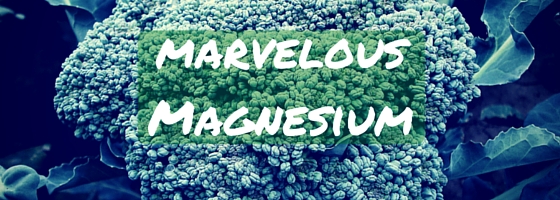What one mineral do most Americans fail to meet their daily requirement for each and every day? Magnesium. In fact, over 80% of Americans fail to get their daily dose. Yet, the importance of magnesium to the body can’t be overstated. It is involved in more than 300 different enzyme pathways, driving our biochemistry. Magnesium is needed for new cell growth, and bone formation, making it essential for maintaining strong bones. It also is involved in activating B Vitamins, producing ATP (the body’s “energy currency” for life) and helping to build the proteins and fats that are essential to our physiology. Magnesium is especially important for cardiovascular health. It acts as a natural calcium-channel blocker and helps to relax the blood vessels, making it important in normalizing high blood pressure. It is also known to help stabilize irregular heart rhythms.
Magnesium has a “relaxing” effect on the body, thus it is very beneficial for asthma, pre-menstrual tension, cramping associated with menstruation, hypertension, and muscle cramps. Most women who are taking calcium supplements to prevent bone-loss may fail to look for a supplement with adequate magnesium. Magnesium allows for the calcium to get into the bone-matrix and make “hard” bone. It is essential in preventing osteoporosis. If you take a bone support supplement, make sure it contains magnesium. And if it contains magnesium oxide, you might want to rethink the supplement, as magnesium oxide is poorly absorbed. Magnesium chelates like malate, glycinate, and aspartate are preferable forms. OsteoForce Supreme is a great bone-support supplement with highly absorbable forms of minerals, and a nice dose of vitamin D, which is also essential for maintaining strong bones.
Magnesium is crucial to the proper functioning of insulin, making it important for diabetics, or anyone with blood sugar regulation issues. In fact, magnesium deficiency is linked to the exacerbation of diabetes and metabolic syndrome. One reason for this link could be the role magnesium plays in energy production. It takes several magnesium atoms to turn one molecule of glucose into pyruvate through the metabolic process known as glycolysis in the cell, which in turn produces ATP. This is just a fancy way of saying it takes magnesium to drive your body’s cells to burn (or metabolize) sugar. Magnesium supplementation has been shown to improve diabetes and metabolic syndrome.
The RDA for magnesium is 320mg/day for women and 420mg/day for men. Generally, taking 200 mg per day through supplementation provides insurance that you are getting enough, however it is best to consult with me as to what the best supplementation regime may be, as everyone’s needs are individual. It is always food first though, so let’s take a closer look at good food sources for this vital mineral.
You may know that the iron molecule is what makes blood red. Iron is a primary component of hemoglobin. But did you know that it is the magnesium molecule that gives chlorophyll it’s green color? Chlorophyll works for plants, much like hemoglobin does for animals. This being said, greens are an excellent source of magnesium. Great sources for magnesium include: dark leafy greens, nuts and seeds (especially pumpkin seeds), fish (especially halibut and salmon), beans, lentils, and artichokes. Here are a few more foods with a handy chart, so you can start upping your high magnesium foods today!
| Magnesium Foods
Food Magnesium / mg |
| Pumpkinseeds, 1/4 c 186 |
| Artichoke, medium boiled 180 |
| Spinach, boiled 1 c 157 |
| Chard, boiled 1 c 150 |
| Flaxseeds 1/4 c 140 |
| Chinook Salmon, 4 oz 137 |
| Sunflower seeds, 1/4 c 127 |
| Sesame seeds, 1/4 c 126 |
| Halibut, 4 oz 121 |
| 100% Bran Cereal, 1/2 c 114 |
| Almonds, 1/4 c 97 |
| Dark Chocolate, 1-ounce 64 |
| Black Beans, 1/2 c cooked 60 |
As always, if you found this blog post helpful, please share with family or friends.






